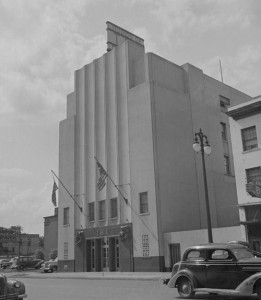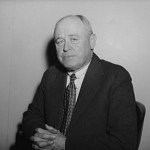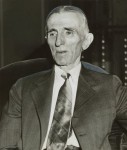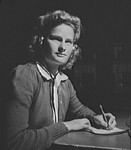A History of the TBC
YOU ARE NOW ENTERING TESLA CITY
A History Of The Fictional City and Its Real Life Architects
by Brendan Douglas Jones
For an all-too brief window of time during the Golden Age of Radio, there was one broadcasting company that did things differently from the rest of the pack. They hired the talent no one else would, they told stories that the others wouldn’t dare and in ways that were decidedly more complex and unique than the norm. And yet, today, hardly anyone outside of the most obsessive fan of the medium even knows that they existed.
The Tesla Broadcasting Company was founded in New York in 1943 and acquired by rival CBS just two years later, bought up mainly for its towers and equipment. While a mere footnote in the history of American radio, the TBC is notable for its unconventional programming and the eccentric entrepreneur who created the company.
The Corporal(?)
“Corporal” Edgerton Spivey, “Buck” to his friends and pretty much everybody else, was born possibly in Dubuque, Iowa in possibly 1886, though there are conflicting stories as to both location and date. Fifty or so years later, he arrived in Manhattan, a self-made millionaire with big dreams and a life story that was, when held up to even the most forgiving scrutiny, almost entirely fictitious.
For example, Spivey claimed to have flown with Allied ace Eddie Rickenbacker during the First World War, though the US Air Service’s records have no mention of him. That fact and a readily apparent fear of flying that was widely noted by those who accompanied him on commercial flights cast serious doubts on the veracity of his claim. When confronted by a reporter about this during one of the few interviews the man gave, Spivey merely shrugged and said he was only afraid of flying when “somebody else’s hand is on the stick.” That same interviewer asked Spivey if he was aware that most of his associates believed his tales of wartime aviation were a fabrication, to which he replied, “If I was gonna invent a military service record for myself, don’t you think I’d give myself a higher rank than corporal?” There the matter rests, one man’s word against the rolls of military history.
Buck Spivey also claimed to have spent many years of leisure as a big game hunter but, after his passing, the only trophy in his possession was an impressive stuffed grizzly bear that still had a tag from a Brooklyn flea market attached to its foot.
The search for any shred of truth in the past of Buck Spivey is a challenge and that certainly extends to the origin of his fortune. His version of the tale had him wildcatting in the Ozarks after WWI, finally striking it rich with the Blue Heaven oil field of Kentucky. Part of this is actually verifiable; Blue Heaven was indeed the source of his wealth but the field was, in truth, originally discovered and drilled by a lifelong oil man named Prescott Braynerd. Though it seems a fantastic, not to mention embarrassing, explanation, on his deathbed, Braynerd confessed that he lost the Blue Heaven deeds to Spivey in a high-stakes game of canasta.
One aspect of Spivey’s life that cannot be doubted, however, is his long fascination with and patronage of the eccentric genius Nikola Tesla. Their odd friendship is under-documented and ill-defined, but it was significant enough that Spivey founded and named his broadcasting company just two months after the great man’s death in ’43. And, in another form of tribute, instead of setting his shows in New York or a generic urban setting, he informed the producers and writers of the TBC that their programs would occur in a fictitious, contemporary metropolis called Tesla City.
The Mad Scientist
While “Corporal” “Buck” Spivey was a somewhat nebulous figure with a mostly fictional life story, one can verify his arrival in New York City in September of 1936, entering high society as a fifty-year old millionaire seemingly unaffected by the lean years of the Depression. It’s also a documented fact that, in February 1943, Spivey got into the radio biz in a big way, sinking a large chunk of his fortune into the founding of the Tesla Broadcasting Company. In the seven years between those events, Spivey met three people who would have a great effect on his life. One was the notorious mobster Meyer Lansky whom Spivey encountered, strangely enough, through wartime work they were both doing for naval intelligence. Another would be Meifeng Wei, the sixteen year-old Chinese circus performer and contortionist who would become the last of Spivey’s wives. And third would be Nikola Tesla.
Though he’s become something of a cult figure over the years (hell, he was even played by David Bowie in a movie once), not everyone is familiar with the Croatian-born genius Nikola Tesla. By the time he emigrated to America in 1884, Tesla was already recognized as a brilliant electrical engineer with daring, some might (and certainly did) say crazy, ideas. A former employee and eventual rival of Thomas Edison’s, Tesla became known to the general populace as much for his penchant for vaudevillian showmanship as for his theories and inventions. He was the creator of the alternating current induction motor and was a pioneer in the fields of X-Ray and remote control-technology. But, behind all of his far-reaching experiments and multitudinous patents, he envisioned something bigger and better for the entire planet – free energy and universal communications. In our broadband world, it’s easy to dismiss the impact of one brilliant futurist preaching to the people of the 1890s about the possibility of wireless communication and the lossless broadcasting of power through the ether, but, in his day, such concepts amounted to lunatic science-fiction. By his contemporaries, he was seen as a courtly wizard, the prototypal “mad scientist.”
At the height of his fame, Tesla was a darling of the intelligentsia, becoming a close friend of Mark Twain’s in the process. A tall, thin, dashing figure in evening clothes, he was often welcomed into the circles of wealthy, powerful men such as J. Pierpont Morgan and George Westinghouse who served as an employer and patron. At the dawn of the Twentieth Century, it was hardly a Manhattan social event of note without an in-person demonstration of the lightning-hurling coil that would bear its inventor’s name. But the years were not kind, investors turned away as the inventions grew more impractical – as he began espousing ideas about communication with alien intelligences and his plans for a directed-energy “death ray” the bankrupt scientist was offering to sell the US military. As rumors of his slide into madness grew, the invitations to the parties and dinners dried up. His star faded, Tesla became a living footnote, living on charity in a succession of New York hotels, and spending the vast majority of his time feeding pigeons in the park.
In 1937, at a high society soirée similar to those once attended by the brilliant inventor decades prior, “Buck” Spivey, looking to escape the stultifying chatter of magnates and millionaires, as well as dodge the advances of middle-aged widows and blue-blood spinsters, ducked out of his host’s Fifth Avenue mansion to get some air. Strolling into Central Park, he happened to take a seat on the same bench as a gangly yet elegant, threadbare old gentleman with a bag of bread crumbs in his lap. Within moments, Spivey knew he was chatting with Nikola Tesla. The highly-unscientific, accidental millionaire grew quite fond of the octogenarian genius and, after this first encounter, they arranged for regular meetings in the park and occasional lunch dates at fine Manhattan restaurants. It’s hard to say what Tesla thought of his new acquaintance as the scant mentions of Spivey sprinkled throughout the old man’s correspondence refer to him as “a most colorful oil baron” who “does not seem to understand the simplest of my theories.”
More than likely, Tesla, even at this late stage of life, was simply hoping for his next patron – a rich man to bankroll the experiments he was sure would change the world for the better and fulfill his vision of the future. The one mention of Spivey that most interests those of us scavenging through the history of the TBC, is found in Tesla’s final letter to his friend Robert Johnson before the poet’s death: “Buck is looking into a new business venture. He asked me if I knew anything about radio.”
Ironically, though history accords the honor of first radio broadcast to Guglielmo Marconi in 1901, that broadcast was made using methods and equipment patented by Tesla a year earlier. In 1943, the year of Tesla’s death and the launch of the TBC, the US Supreme Court retroactively honored those patents, thereby acknowledging, quietly, that Tesla was the true father of radio. Maybe this was fresh in Spivey’s mind when he incorporated the Tesla Broadcasting Company, naming it in tribute to the man he recalled as, “a true-blue genius and a genteel soul…who always stank of bird shit.”
The Architect
True, Buck Spivey founded the company, but beyond providing the typewriters and the floor space in a building on Staten Island and signing the checks, the Corporal had little to do with the creation of the stories that made this small broadcasting concern so memorable. His primary contribution on that front was hiring an amazingly talented woman as his head writer. Her name was Dave Engstrom.
Most of the information on Engstrom used for this history comes from a career retrospective interview she gave to Broadcasting Magazine in 1979. Recognized as one of the unsung heroes of women in the entertainment field, the interviewer made an incorrect assumption that Engstrom had taken the nom de plume of “Dave” Engstrom to give herself an advantage in a male-dominated field. “No, dear,” Engstrom told the interviewer, “I was Dave on entry to this world and I’ll be Dave on my way out.”
In the official record, she was born Davina Vera Engstrom to her parents Richard and Zaidie on May 9th, 1918 in Savannah, Georgia. A precocious reader from a young age, her favorites were the dime store “men’s adventure” novels in which her father, a successful lawyer, guiltily indulged. By the age of six, she was already writing her own child-like thrillers and signing them “Dave Engstrom.” A somewhat introverted youngster, she continued to write fiction and plays throughout her school days. When university loomed, she chose Tufts University, originally majoring in Literature before switching to Dramatic Arts in her second year. “I fell in love with an actress,” she explained.
It was for that girlfriend that she created her first radio work. For the 1938 academic year, Dave was the sole writer of a campus radio serial called “Dolly On the Dial,” an ingenious series which followed a young woman heroine who habitually falls asleep listening to the radio and finds herself suddenly inhabiting the fictional programs being broadcast. This allowed Engstrom, week after week, to offer up spot-on parodies and pastiches of every popular show of the day. The character of Dolly blundered through sitcoms, soap operas, thrillers, kiddie adventure shows and dance music programs. It was the perfect, if unwitting preparation for the job she would eventually have.
Out of school with a useless degree, Dave headed to the theater Mecca of the free world: New York. She caught the attention of Spivey in the summer of 1941 when she was mounting an off-Broadway production of Medea, which she had freely adapted by transposing the central characters with those from the comic strip “Blondie.” The production received much advance publicity, mostly negative, excepting a public blurb of encouragement from Orson Welles and John Houseman of the Mercury Theater. Medea Bumstead was shuttered without a single public performance.
While Spivey was underway building the TBC, and with no clear ideas as to programming, he read and enjoyed Engstrom’s playwriting, even going so far as acquiring acetates of her college radio work from Tufts. “Dolly On the Dial” was perhaps too brainy and arch for the masses, but clearly this was a writer in command of any genre she turned her attention to. He decided to court this young, quietly subversive lesbian playwright.
“Corporal” Buck Spivey was no reformer or progressive, just a businessman who knew talent when he saw it – specifically overlooked, unhireable talent that he could get cheap. He took the young woman to lunch at an automat in Manhattan and asked her if she could oversee a programming block of seven or eight original radio shows. Said Engstrom, “This odd, but likable gentleman whose eyes never rested on you or anything else for more than half a second, had, between bites of a tuna melt, just offered this unproven 23 year-old nobody the opportunity to create and guide the entire creative output of a brand new radio network. I was dumbstruck but recovered quickly. In answer, I set down my fork and accepted the job. We shook on it and then I excused myself to the ladies room where I proceeded to vigorously regurgitate for an alarming amount of time.”
Thus a young woman playwright was named Creative Director and head writer of the Tesla Broadcasting Company. It was Engstrom who, pretty much single-handedly, created the unique experiment that was the TBC universe. She spoke a bit about the concept and her process in the Broadcasting Magazine interview.
“The Corporal had given me carte blanche to develop a slate of shows in various genres and to hire whomever I wanted to write for them. It was virtually unheard of for any neophyte writer to be offered such a deal, much less a woman neophyte writer, and I was damn well not going to squander the opportunity.
“Content-wise, I wanted to give the public what they were accustomed to: comedy, romance, thrillers, tear-jerkers. We didn’t reinvent the wheel. We followed the traditional two-acts with a commercial block in the middle structure created by Aristotle, but I just couldn’t resist tweaking the format a little. I’d almost immediately had this crazy thought, ‘what if all our shows took place in the same city?’ A place that was but wasn’t New York, essentially. And that thought naturally led to, ‘what if our characters bumped into each other on the street and their stories, their lives, got all tangled up regardless of their native genre?’ That flash of inspiration was both the best and worst idea I ever had in my life.”
Engstrom did acknowledge that she’d been partially inspired by the occasional practice of radio stars making cameos on other shows, but those instances were essentially popular comedians playing themselves and dropping by the shows of other popular comedians also playing themselves, the classic Jack Benny-Fred Allan “feud” enacted in reciprocal cameos being the best example. But that was too simple and limited for Engstrom who saw much more potential in an interconnected landscape of radio drama. “To me it was such a wonderful and absolutely obvious concept. I mean, if you took network ownership out of the picture, you had characters sharing timeframes and settings that could, conceivably, all be a part of the same world. And who wouldn’t want to hear an episode of Gunsmoke with the Lone Ranger and Tonto guest-starring? Wouldn’t it have been amazing for Little Orphan Annie, caught in another criminal snare, to be rescued by The Shadow or the Green Hornet? What if Our Miss Brooks reunited with an old high school sweetheart who turned out to be Joe Friday of Dragnet? You get the picture. Well, here I was building a world from the ground up, so I would purposefully create interrelations between all our shows, I built it into the architecture of Tesla City. It got a little tricky when we did our westerns and space adventure shows, but that was also part of the fun.”
Most of the time, these interactions were incidental and subtle, but even so, Engstrom and her staff realized the other side of such a structure was the thorn of continuity. “That was our dreaded ‘c word.’ We had to have big pads of paper up in the office and 3×5 cards to keep track of what was happening in one show that might affect events in another. If a supporting character in one show gets engaged to a character in another, we had to make sure that acknowledged across all the shows. Maybe nobody listening cared, I mean, who knows, but we felt the need for some internal consistency and attention to detail.”
Along these same lines, Dave alluded to the shows TBC collectors have come to treasure most – the company-wide crossovers. “We were ambitious in a way I think almost no one in the industry was at the time. I had the bright idea to do big storylines once a year that would tie all the shows together. These were fantastical stories that could never have been attempted in the movies and I was proud of them even if they were all, every one of them, a nightmare to produce. Our first one was kind of a supernatural brouhaha and it focused on the Wraith. Big doings, huge cast, crazy sound effects, but, I think, a success. It was certainly the first time we got outraged emails from church groups and history professors. That’s when I knew all the work had been worth it.”
To be continued…
THE TESLA CITY STORIES
3439 NE Sandy BLVD. #317
Portland, Oregon 97232
ph: 503.877.3341
Original Vintage Radio Theater Live & Direct From 1944!
A production of Raygun Gothic LLC • ©2014 Tesla City Stories - All Rights Reserved.
THE TESLA CITY STORIES
3439 NE Sandy BLVD. #317
Portland, Oregon 97232
ph: 503.877.3341
Original Vintage Radio Theater Live & Direct From 1944!
A production of Raygun Gothic LLC • ©2014 Tesla City Stories - All Rights Reserved.





